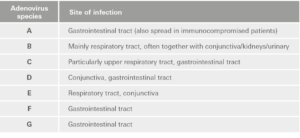Currently, many patients are presenting themselves at the doctor’s with symptoms of the common cold, such as cough, runny nose, headache and fever. These symptoms are typical of this time of year and can be caused by a number of different pathogens. In many cases, only differential diagnostics can help to identify the pathogen and to determine which further medical procedure is indicated.
In Germany, the current incidence of acute respiratory infections (ARI) is still at a relatively high level for this time of the year. The latest weakly ARI report from the RKI shows that rhinoviruses are currently the most common viruses in the population. This is followed by adenoviruses, far behind in the number of cases but still ahead of RSV.
Adenoviruses are common cold viruses, which usually only cause mild illness. Most individuals recover fully from these viral attacks on the immune system. However, certain groups of people are at risk of experiencing a course of infection that can be life-threatening.
Adenovirus: Short profile
Adenoviruses are a group of highly infectious DNA viruses, which is divided into seven human pathogenic species (A to G) with a total of 57 different serotypes. They are transmitted by direct contact with infected patients, aerosols or contaminated objects or fluids. Depending on the species, they multiply mainly in the respiratory and gastrointestinal tracts and in conjunctival cells and can therefore also cause other diseases such as intestinal infections or conjunctivitis (see table).

Most immunocompetent individuals infected with adenovirus have an asymptomatic course. Symptoms are most common in infants and children. Respiratory infections present with fever and respiratory symptoms, including tonsillitis, which can be difficult to distinguish from group A streptococcal pharyngitis. In rare cases, severe forms of bronchiolitis or pneumonia may occur. In addition, immunocompromised people are especially at risk of developing severe complications such as ARDS (acute respiratory distress syndrome). Reactivation of a persistent (latent) adenovirus infection is also common in these patients.
Diagnostics
As many respiratory pathogens cause similar symptoms, the diagnosis cannot usually be made based on the clinical picture alone. Laboratory diagnostics is therefore particularly important.
During the acute phase of a respiratory infection, PCR tests can be used to detect adenovirus DNA in respiratory secretions. This is useful when patients are suffering from a severe infection and a diagnosis is needed to start appropriate treatment to prevent possible complications. Clear identification of respiratory pathogens can also be important for infection prevention and control, e.g. to identify sources of infection and contain potential outbreaks.
Serological tests can help to detect antibodies against adenovirus. Antibodies indicate past infection and are helpful in determining a person’s current immune status. Serology can also be useful in epidemiological surveillance.
EUROIMMUN offers PCR-based assays for direct detection as well as antibody tests for differential diagnostics in respiratory infections. The multiplex test EUROArray PneuVir is able to detect 17 respiratory pathogens at once, including adenoviruses. For single detection in case of suspected adenovirus infection, the RT-PCR GeneProof Adenovirus PCR Kit1 is available. In addition, antibodies of the immunoglobulin classes A, G and M against adenovirus can be determined by means of EUROIMMUN ELISAs. For convenient testing in the laboratory routine, EUROIMMUN offers flexible automation solutions, depending on the throughput or needs of the laboratory.
If you want to learn more about our range of products for respiratory infection diagnostics, visit our website:
Respiratory infections | EUROIMMUN
* manufactured by GeneProof
Heim A, Dürrwald R: Infections with human adenoviruses. (In German) Epid Bull 2019;22:187 – 189 | DOI 10.25646/6158

